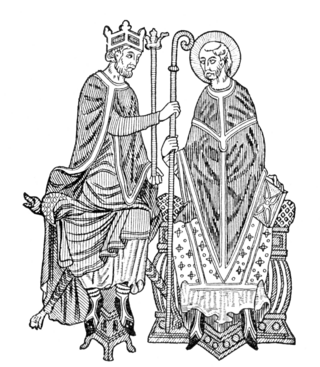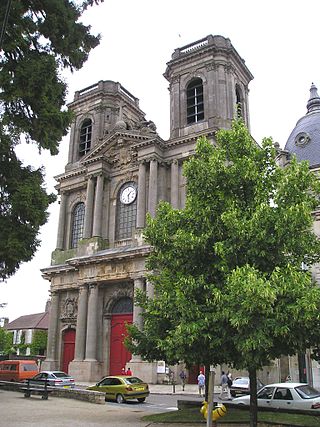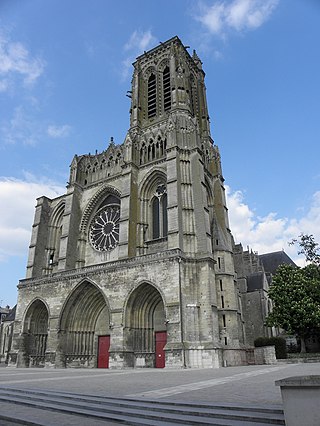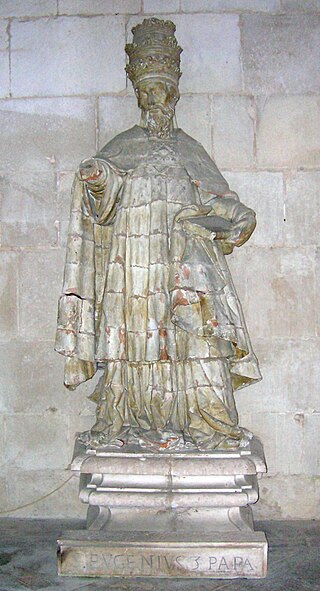Pope Alexander II, born Anselm of Baggio, was the head of the Roman Catholic Church and ruler of the Papal States from 1061 to his death in 1073. Born in Milan, Anselm was deeply involved in the Pataria reform movement. Elected according to the terms of his predecessor's bull, In nomine Domini, Anselm's was the first election by the cardinals without the participation of the people and minor clergy of Rome. He also authorized the Norman Conquest of England in 1066.

Pope Victor III, was the head of the Catholic Church and ruler of the Papal States from 24 May 1086 to his death. He was the successor of Pope Gregory VII, yet his pontificate is far less notable than his time as Desiderius, the great abbot of Monte Cassino.

Pope Gregory VII, born Hildebrand of Sovana, was head of the Catholic Church and ruler of the Papal States from 22 April 1073 to his death in 1085. He is venerated as a saint in the Catholic Church.

The Investiture Controversy or Investiture Contest was a conflict between the Church and the state in medieval Europe over the ability to choose and install bishops (investiture) and abbots of monasteries and the pope himself. A series of popes in the 11th and 12th centuries undercut the power of the Holy Roman Emperor and other European monarchies, and the controversy led to nearly 50 years of conflict.

Bruno of Cologne, OCart, venerated as Saint Bruno, was the founder of the Carthusians. He personally founded the order's first two communities. He was a celebrated teacher at Reims and a close advisor of his former pupil, Pope Urban II. His feast day is 6 October.

The Archdiocese of Reims or Rheims is a Latin Church ecclesiastic territory or archdiocese of the Catholic Church in France. Erected as a diocese around 250 by Sixtus of Reims, the diocese was elevated to an archdiocese around 750. The archbishop received the title "primate of Gallia Belgica" in 1089.

The Diocese of Langres is a Latin Church diocese of the Catholic Church comprising the département of Haute-Marne in France.

The Musée Saint-Remi is an archeology and art museum in Reims, France. The museum is housed in the former Abbey of Saint-Remi, founded in the sixth century and which had been keeping since 1099 the relics of Saint Remigius. The Basilica of Saint-Remi, adjacent to it and consecrated in 1049, was its abbey church. Both buildings have been listed as part of a UNESCO World Heritage Site since 1991 because of their outstanding architecture and importance in the early French monarchy.
Saint John of Gorze was a Lorraine-born monk, diplomat, administrator, and monastic reformer.
Manasses I, known as Manasses de Gournay, was the Archbishop of Reims, and thus primate of France, from c. 1069 to his deposition on 27 December 1080.

The Diocese of Amiens is a Latin Church diocese of the Catholic Church in France. The diocese comprises the department of Somme, of which the city of Amiens is the capital. In 2022 it was estimated that there was one priest for every 6,916 Catholics in the diocese.
Hugh of Die was a French Catholic bishop.

The Diocese of Soissons, Laon, and Saint-Quentin is a Latin Church diocese of the Catholic Church in France. The diocese is suffragan to the Archdiocese of Reims and corresponds, with the exception of two hamlets, to the entire Department of Aisne. The current bishop is Renauld Marie François Dupont de Dinechin, appointed on 30 October 2015. In 2022, in the Diocese of Soissons there is one priest for every 5,594 Catholics.

In 1148, a Council of Reims was called by Pope Eugene III to consider a variety of issues for the Church. Originally the summons to the council went out in October 1147 and it was supposed to be held in February 1148 at Trier, but conditions there were such that it was moved to Reims. A number of the bishops and other Churchmen who had been convoked did not attend and Eugene suspended many of the non-attendees, excepting the other Churchmen of Italy, who were excused. The council convened on 21 March 1148 and is said to have lasted 11 days in total, which would give an end date of 1 April 1148. However, it is possible that it was shorter, given that the large increase in the population of Reims would have strained the town's resources.

The 1086 papal election ended with the election of Desiderius, abbot of Monte Cassino as Pope Gregory VII's successor after a year-long period of sede vacante.
Gerard II, sometimes Gerard of Lessines, was the thirty-third bishop of Cambrai from 1076 and the last who was also bishop of Arras. He was a prince-bishop of the Holy Roman Empire, and his episcopacy coincided with the beginning of the Investiture Controversy between emperor and pope.
Herbert Edward John Cowdrey (1926–2009), known as H. E. J. Cowdrey or John Cowdrey, was an English historian of the Middle Ages and an Anglican priest. He was elected priest of St Edmund Hall, University of Oxford, in 1956. He resigned the chaplaincy in 1976, but continued to teach medieval history there until 1994, when he retired and was elected emeritus fellow. He was also a Fellow of the British Academy. A leading expert on the Gregorian reforms, his most important work is the monograph Pope Gregory VII, 1073–1085, considered a masterpiece "unlikely to be surpassed".
Theoderic, or Thierry, was a royalist bishop of Verdun from 1047 to 1089. Before his consecration, he was a chaplain of Henry III.
Helinand was the bishop of Laon from 1052 to 1098.
Drogo was bishop of Thérouanne from 1030 to 1078. Very little is known about his early life, except that he was a cleric from Amiens and a monk from Saint Bertin, where he learned music from Enguerrand, abbot of St. Riquier. At the beginning of his episcopate, he was in conflict with Baldwin IV, Count of Flanders, who ousted him in 1030, probably in the context of his conflict with his son, Baldwin V. By 1032 he was back at his siege, and from 1035 he frequently appeared alongside the younger Baldwin. In 1036 he substituted for bishop Fulk of Amiens at the elevation of the relics of St. Adalard at Corbie. He was a participant of the Council of Reims in 1049, where he made count Baldwin sign a "Peace of God" agreement, promising to respect merchants, clerics, women and church assets. In 1052, he performed the elevation of St. Omer and St. Bertin. During his episcopate, at least five new religious houses were founded, and all of them received privileges from him: a nunnery at Mesen, canonries at Voormezele, Ardres and Zonnebeke, and a priory for canons regular at Watten.









